Earlier in the week, as I drove to the Missouri River I was keenly aware that a Snowy Owl sighting could be a possibility, and that was the case again during a birding drive Saturday afternoon. I was on my way back to Napolean Lake with the hope of more opportunities to observe and photograph Arctic-nesting geese and swans. Driving westward, as I topped a hill east of Wentz Lake I could see a field accented by an expansive white blanket that looked like snow from a distance, but it was composed of thousands of feeding Snow Geese. Similarly, my attention was drawn low to the south side of the road, where a snow-like white alkali salt covered a small area of bare ground – and was that an owl standing in its midst – a Snowy Owl! Wowee!
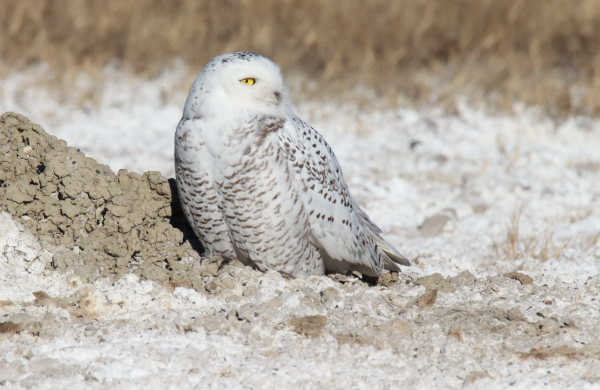
The initial excitement of seeing a Snowy Owl was eclipsed by the chance to take photos such as this in full afternoon sunlight – after hiking around a low hill to get into position with the sun at my back and my shadow pointing toward the young owl (600mm zoom lens, f-8 aperture, 1/4000 shutter speed, 800 ISO).
The grand owl was facing away from me and its back was shaded dark gray, nonetheless there was no doubt that this was a Snowy Owl and it offered something of a chance to photograph it. First, I needed to get around to the sunny side of the great white owl and approach it with the sun at my back and my shadow pointing toward the owl. Could I manage some photos? Let’s give it a try! After parking my car and double-checking my camera’s settings, I stretched my legs over a taut barbed-wire fence and followed a deer path to a little hill located between me and the owl. The path made it easier to walk across the open prairie while allowing me to walk more quietly. There was no cover beyond the hill, so I crouched down a bit, pre-focused on a spot on the hillside that I thought might be similar to the distance between the owl and me when I rounded the corner. I also kept my camera raised to my face to avoid making too much motion when I initially came into the view of the owl. Oh, it was getting mighty exciting as I cautiously rounded the base of the hill, and there it was!
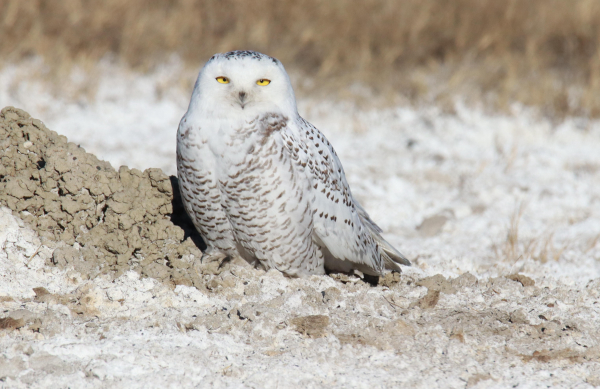
In advance of hiking into position to photograph the Snowy Owl, I checked my camera settings, but was happy with the pre-set f-8 aperture. Considering the resulting ultra-fast shutter speed, I could easily have used an f-9 or f-10 aperture too (600mm zoom lens, f-8 aperture, 1/4000 shutter speed, 800 ISO).
I focused directly on the white owl, bathed in afternoon sunlight and surrounded by white alkali-covered ground – but the Snowy was actually looking away, showing the back of its head. Well, that was a surprise, but it gave me a chance to be ready and know it wouldn’t be a rushed photo opportunity. When the owl finally turned its head my way I took a couple quick documentary photos in case it became scared, but that seemed to be no problem as the owl looked to the side, behind it, and forward again as I took a representative photo with each motion. Woowee, how kool was this! The owl was obviously a young bird as noted by the horizontal brown barring on its breast feathers, and as I watched and photographed, I wondered if the young Snowy had ever seen a person before? Was it newly arrived from the Arctic? Did it make a stop in a prairie province on its way south from the Arctic?
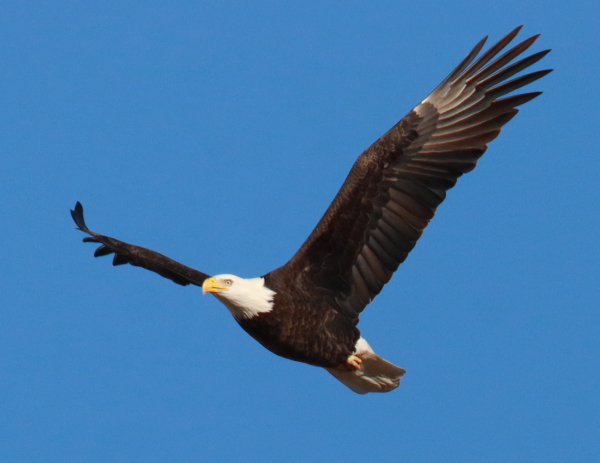
After an initial photo session with the owl, the sight of an adult Bald Eagle approaching overhead made me wonder if it was checking out the owl, or me, but I made the most of the opportunity as it flew into the afternoon sunlight (600mm zoom lens, f-8 aperture, 1/3200 shutter speed, 800 ISO).
After about 2 minutes, I’m not sure why, but I looked up from the camera and saw an adult Bald Eagle headed our way. Gee, of all the times to see an eagle, but I became interested in what its intention was as it flew directly toward the owl and me, wondering which of us it was most interested in checking out. Or maybe it wondered what I was doing in the company of the Snowy Owl. Even with the rarer owl nearby, I instinctively raised my camera and focused on the eagle flying toward us in sweet afternoon light. I took a series of photos until it passed directly overhead, and checked on the owl to see if it reacted. Apparently not, but without me knowing, the big Bald Eagle circled back and as I saw its shadow pass overhead the Snowy Owl reacted by beginning a very low flight, sailing just a foot or so above the low grass to the contour of the side of the road and landing at the position where I had initially sighted the owl.
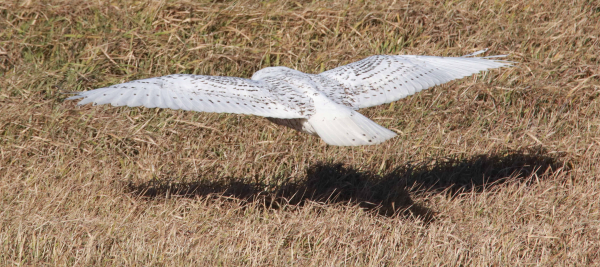
Uneasy about the overhead approach of the eagle, the young Snowy Owl made a short flight just above the ground vegetation to an elevated position, providing this interesting photo in the process that shows its anterior plumage and broad wingspan, complete with a shadow (600mm zoom lens, f-8 aperture, 1/4000 shutter speed, 800 ISO).
Luckily, instead of gliding over the road, the white owl landed on the grass on the edge of the roadside, which was elevated about 15 feet above my position on the edge of the drying wetland. Having photographed the young owl’s progress as it flew directly away and up the elevated road bank, I also photographed the Snowy as it landed, folding its wings with its eyes alert and opened wide. From my position, the owl was now standing with clear blue sky behind it, offering a completely different setting for me to photograph the owl – and I didn’t even need to move. The owl settled down quickly, and provided similar photo ops with the blue sky background. But at the same time, the owl was now standing next to the road, so I watched for a vehicle on the little-used rural roadway.
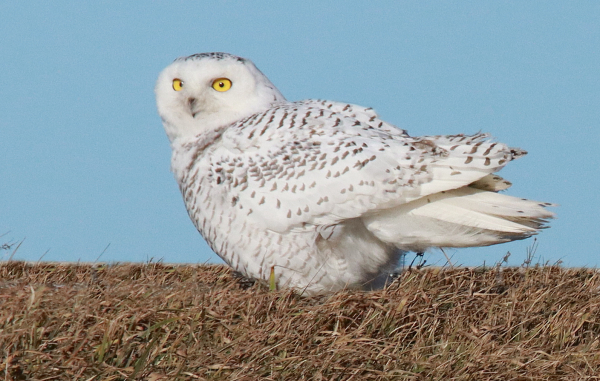
Having just landed and still folding its wings into position, the young Snowy Owl shows an alert concern in its eyes, but it quickly settled into a more relaxed position that is reflected in the following photograph (600mm zoom lens, f-8 aperture, 1/4000 shutter speed, 800 ISO).
Eventually, a pickup truck approached, so while I hoped the owl didn’t flush in front of the truck, I was ready to photograph it flying in case it did take flight. It was a little tense as the seconds seemed to be especially long and the owl waited until the last moment to fly (I bet the truck driver was surprised when the owl’s long wings flashed before him). The owl flew into the northwest wind, showing me a bit of a side view with full sunlight illuminating it, but it suddenly turned to circle back, catching the wind and racing off to my side. I lost the focus on the owl for a split-second but refocused as it flew by me broadside. It seemed that it wouldn’t fly far, and indeed it landed about 60 yards to the south on a low hilltop, and that’s where I left the young Snowy Owl to continue the rest of its afternoon in subdued comfort.
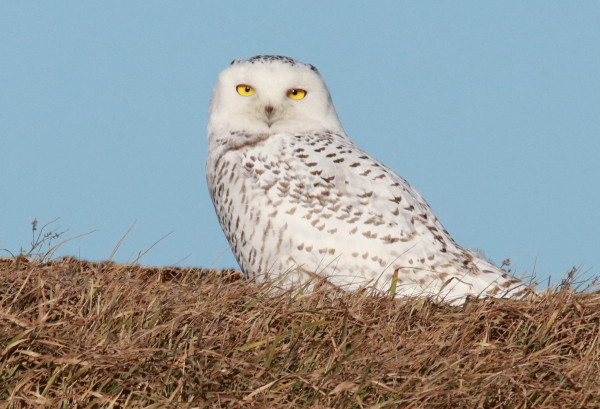
The new position of the owl not only provided a second setting for photographs, but its elevated position with the clear sky background really emphasized how impressive the Snowy Owl was in its late fall surroundings (600mm zoom lens, f-8 aperture, 1/4000 shutter speed, 800 ISO).
How long had the Snowy Owl been here? How long would it stay? Where would it move to next? It’s possible to get an idea of how much some Snowy Owls meander across broad regions from information being generated by Project Snowstorm as researchers track the movements and behavior of individual Snowy Owls that have been fitted with a GPS-based transmitter (learn more in the Birding News 2 article in this issue). Some birds do a lot of traveling throughout the winter, while others seem to find a favorable location and stay there for an extended period, although they may cover several miles within a stopover locale. One thing is for sure, every Snowy Owl is different, but they are all stunningly impressive.
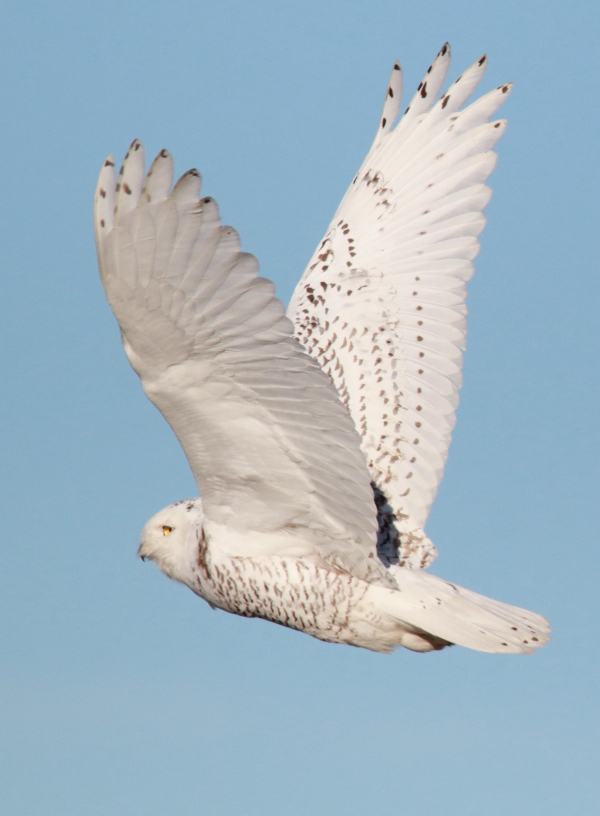
The best of my flight photos, taken after a truck approached and sent it into a repositioning flight, really shows the long wings of a Snowy Owl, a measure of the strong wingbeats that propelled it across the bright northern sky (600mm zoom lens, f-8 aperture, 1/4000 shutter speed, 800 ISO).
|
The evening before I read the new report from Project Snowstorm that reported that a significant early migration of young Snowy Owls was pushing into the southern areas of Canada’s prairie provinces and southern Ontario, as well as northern areas of the Great Lakes states. It was certainly good news, and now I was being thrilled by my first Snowy Owl sighting of the season. Snowy Owls are simply magnificent, every one of them, and I never see enough of them, even though I have had winter counts of 87 and 78 during my best Snowy years. But Snowy Owls have been scarce or non-existent during the past few years. The most recent one I observed was last Christmas Eve as I began driving home in the dark after a family dinner and gift giving celebration, and there were none to be seen the prior winter; so this early season sighting is quite exciting and hopefully will lead to more Snowy Owl observations as winter weather arrives.
The young Snowy Owl that I spent time with Saturday was a true representative of its species: Calm, trusting, and beautiful with an underlying intensity that makes it a standout in nature wherever it goes, from the Arctic to open temperate regions. This bird made quite an impression on me and helped me remember why I count Snowy Owls among my favorite birds in the world. I can only hope there will be many more observations of these winter visitors in my near future, and some photos too; while hoping this young owl will faire well wherever it wanders. I hope you will have at least one Snowy Owl experience this season, and more if you are lucky – Good Luck.
Article and Photographs by Paul Konrad
Share your bird photos and birding experiences at editorstbw2@gmail.com